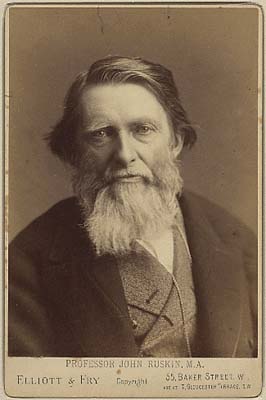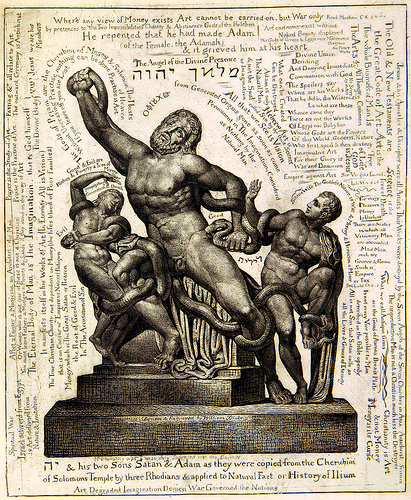 It is hard to overstate John Ruskin's impact on art, and the more i read about him, the more i am convinced that this post will not do justice to the man who, according to Charlotte Bronte, taught an entire generation how to see. His proteges included John Everett Millais, William Holman Hunt, Oscar Wilde, and William Morris. His writings on political economy were also not bad. Cecil Rhodes and Tolstoy were fans. Gandhi had something of a conversion experience whilst reading Ruskin's Unto This Last on a train from Johannesburg to Durban. According to a survey of the first Parliament in which Labour managed to get seats, that very book had more of an impact on the Labour Party members than Das Kapital.
It is hard to overstate John Ruskin's impact on art, and the more i read about him, the more i am convinced that this post will not do justice to the man who, according to Charlotte Bronte, taught an entire generation how to see. His proteges included John Everett Millais, William Holman Hunt, Oscar Wilde, and William Morris. His writings on political economy were also not bad. Cecil Rhodes and Tolstoy were fans. Gandhi had something of a conversion experience whilst reading Ruskin's Unto This Last on a train from Johannesburg to Durban. According to a survey of the first Parliament in which Labour managed to get seats, that very book had more of an impact on the Labour Party members than Das Kapital. Ruskin aspired to write like Richard Hooker and George Herbert. Volume II of his Modern Painters (1846) is consciously styled after Hooker's Of the Lawes of Ecclesiastical Polity. Ruskin invokes Hooker for his conception of moderation as beauty:
He also seems to draw heavily on Hooker in his discussion of unity amid variety, or what Hooker would call 'harmonious dissimilitude', and in his discussion of the delight of creating, Ruskin also borrows from Book V of Of the Lawes of Ecclesiastical Polity. For an awesome article about Anglicanism and art, click here.
Ruskin's influence is as durable as it is expansive; he's a particular favourite amongst woodworkers in our time. One of my favourite blogs, Chris Hall's 'The Carpentry Way', which is about eastern and western woodworking, refers to Ruskin numerous times in his series 'The Master Builder Tradition-What Happened?'. Evan Adams is quite forthcoming about Ruskin quotes being one of the main features of his fantastic blog, and Brad at treefrogfurniture explains the evolution of Dutch Arts and Crafts in the United States! By and large, it seems that Ruskin's The Seven Lamps of Architecture (1849),which you can read here, is the most popular amongst woodworkers.
The Seven Lamps of Architecture was published in May 1849, the first of Ruskin's works to carry his name, and the first to be illustrated, with fourteen plates drawn and etched by him. A reference in the preface to the depredations of 'the Restorer, or Revolutionist' made Ruskin's position clear. He wished to protect what survived, and draw from it certain principles which would influence the direction of the Gothic revival, notably towards the use of Gothic in secular buildings. His purpose was both to secularize and make protestant the movement, drawing it away from the Roman Catholic influence of Augustus Welby Pugin. His intervention was theoretical rather than practical: the 'lamps' of architecture were moral categories-sacrifice, truth, power, beauty, life, memory, and obedience. Like the types of typical beauty in Modern Painters, volume 2, they are abstract notions in themselves, but for Ruskin were manifested in particular Gothic buildings in Italy and northern France. (ODNB)
Whilst in Oxford, he had been acquainted with many giants of the literary and artistic scene:
Ruskin recruited Wilde into a group of social activists trying to build a road, and his anger at social cruelty found fallow soil in the boy from the famine-writers' house. Pater and Ruskin shaped Wilde's thought and its expression: they did not originate it. Initially he brought their ideas and his glosses into the market place in lectures on aesthetics in the UK and the USA. Thereafter he embedded them, begirt in his own wit and charm, in fictions such as The Happy Prince and other Tales and The Picture of Dorian Gray. (ODNB Wilde entry)Ruskin was also friendly with Charles Lutwidge Dodgson, who shared Ruskin's love of sketching (and definitely exceeded Ruskin's love of little girls) and wished to illustrate his own works, such as The Adventures of Alice in Wonderland and Through the Looking Glass. Dodgson had already taken a step back from his work by publishing under the pseudonym 'Lewis Carroll'. Ruskin informed Dodgson that his talents as an artist were 'severely limited.' Dogdson took Ruskin's criticisms quite well, and relinquished even more artistic involvment in his work, hiring professionals to illustrate his books. Nonetheless, Dodgson continued to enjoy sketching and socialised with many artists who were also amongst Ruskin's circle of friends, such as Arthur Hughes, William Holman Hunt, J. E. Millais, Alexander Munro, V. Princep, D. G. Rossetti, J. Sant, C. A. Swinburne, Mrs E. M. Ward, and G. F. Watts.
Ruskin is probably most famous for his relationship with the Pre-Raphaelites, mainly Millais, through their mutual friend, the poet Coventry Patmore. Ruskin defended Millais and the Pre-Raphalites' style against the aesthetic orthodoxy established by dudes like Sir Joshua Reynolds and The Royal Academy, enabling mainstream acceptance of the artistic movement. Hopefully we'll come back to that.
In Millais, Ruskin saw a successor to Turner, and due to the age difference, Ruskin was more like his patron and mentor. You'd think that it was a relationship that Ruskin would kick himself for later, as his wife Effie (Euphemia. i know, right?), ran off with (and later married) Millais. Actually, Ruskin was rather relieved, and the 5-year marriage annulled in court on the grounds that it was never consummated. Against charges of impotence, Ruskin apparently volunteered to drop trou and prove otherwise. Classy. Definitely the kind of thing one would expect from a Victorian art critic:
There is little that is certain about the intimate details of Ruskin's marriage to Euphemia Chalmers Gray beyond the fact that it was never consummated. A medical examination confirmed Effie's virginity, but in a legal deposition that was not introduced in court, Ruskin stated: 'I can prove my virility at once'. This was never put to the test, [thankfully!] but it seems likely that Ruskin was referring to masturbation. Again, there is no confirmation of this, but a letter to a confidante, Mrs Cowper, in 1868 in which he wrote 'Have I not often told you that I was another Rousseau?' has been taken as a discreet reference to the practice. [i don't get it...] At this same time he told a male friend that he had been capable of consummating his marriage, but that he had not loved Effie sufficiently to want to do so. (ODNB)
Nonetheless, Ruskin's conceptions of nature and beauty, combined with a mystical streak made for an interesting collaboration with the Pre-Raphaelites. These were also into reviving Blake, who was into pretty interesting things, among them, mystical Jewish symbolism. Here's a little teaser:

An interesting read. So was there a connection between Ruskin's views and mystical Jewish symbolism?
ReplyDelete